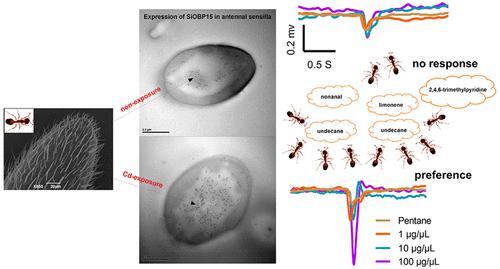当前位置:
X-MOL 学术
›
Environ. Sci. Technol.
›
论文详情
Our official English website, www.x-mol.net, welcomes your feedback! (Note: you will need to create a separate account there.)
Sublethal Exposure to Cadmium Induces Chemosensory Dysfunction in Fire Ants
Environmental Science & Technology ( IF 11.4 ) Pub Date : 2022-08-09 , DOI: 10.1021/acs.est.2c03108 Fuxiang Yang 1 , Guoqing Zhang 1 , Jinlong Liu 1 , Shuanggang Duan 1 , Lei Li 2 , Yongyue Lu 3 , Man-Qun Wang 1 , Aiming Zhou 1
Environmental Science & Technology ( IF 11.4 ) Pub Date : 2022-08-09 , DOI: 10.1021/acs.est.2c03108 Fuxiang Yang 1 , Guoqing Zhang 1 , Jinlong Liu 1 , Shuanggang Duan 1 , Lei Li 2 , Yongyue Lu 3 , Man-Qun Wang 1 , Aiming Zhou 1
Affiliation

|
Ants easily accumulate cadmium (Cd) from the food web in terrestrial ecosystems. Cd contamination may cause olfactory dysfunction and consequently disorders in the social behavior of ants. To explore the molecular mechanism underlying the effect of Cd exposure on the chemosensory process of ants, we characterized the Cd-induced variations in the expression of genes involved in chemoreception and electrophysiological and behavioral sensitivity to semiochemicals by using the red imported fire ant, Solenopsis invicta, as a model system. As a result, Cd exposure increased Cd accumulation and decreased the survival rate of S. invicta. Cd exposure altered the expression profiles of odor binding protein genes of S. invicta (SiOBPs). Specifically, SiOBP15 protein expression was upregulated upon Cd exposure. Both SiOBP7 and SiOBP15 exhibited high binding affinities to limonene, nonanal, and 2,4,6-trimethylpyridine. S. invicta exposed to Cd showed less sensitive electrophysiological and behavioral response to the three chemicals but exhibited sensitive perception to undecane. Silencing of SiOBP7 and SiOBP15 abolished the behavioral response of S. invicta to nonanal and undecane, respectively, suggesting that SiOBP7 and SiOBP15 play essential roles in the chemoreception of S. invicta. In general, our results suggest that Cd contamination may interfere with olfactory signal transduction by altering the expression of SiOBPs, consequently evoking chemosensory dysfunction in fire ants.
中文翻译:

镉的亚致死暴露会导致火蚁化学感应功能障碍
蚂蚁很容易从陆地生态系统的食物网中积累镉(Cd)。镉污染可能会导致嗅觉功能障碍,从而导致蚂蚁的社会行为障碍。为了探索镉暴露对蚂蚁化学感应过程影响的分子机制,我们利用红火蚁Solenopsis invicta来表征镉诱导的涉及化学感受、电生理和行为化学信息敏感性的基因表达变化。,作为模型系统。结果,Cd 暴露增加了 Cd 积累并降低了S. invicta的存活率。镉暴露改变了S. invicta (SiOBPs)气味结合蛋白基因的表达谱。具体而言,镉暴露后 SiOBP15 蛋白表达上调。SiOBP7 和 SiOBP15 均表现出对柠檬烯、壬醛和 2,4,6-三甲基吡啶的高结合亲和力。暴露于镉的S. invicta对这三种化学物质表现出不太敏感的电生理和行为反应,但对十一烷表现出敏感的感知。SiOBP7和SiOBP15的沉默分别消除了S. invicta对壬醛和十一烷的行为反应,表明SiOBP7和SiOBP15在S. invicta的化学感受中发挥着重要作用。总的来说,我们的结果表明,镉污染可能通过改变 SiOBP 的表达来干扰嗅觉信号转导,从而引起火蚁的化学感应功能障碍。
更新日期:2022-08-09
中文翻译:

镉的亚致死暴露会导致火蚁化学感应功能障碍
蚂蚁很容易从陆地生态系统的食物网中积累镉(Cd)。镉污染可能会导致嗅觉功能障碍,从而导致蚂蚁的社会行为障碍。为了探索镉暴露对蚂蚁化学感应过程影响的分子机制,我们利用红火蚁Solenopsis invicta来表征镉诱导的涉及化学感受、电生理和行为化学信息敏感性的基因表达变化。,作为模型系统。结果,Cd 暴露增加了 Cd 积累并降低了S. invicta的存活率。镉暴露改变了S. invicta (SiOBPs)气味结合蛋白基因的表达谱。具体而言,镉暴露后 SiOBP15 蛋白表达上调。SiOBP7 和 SiOBP15 均表现出对柠檬烯、壬醛和 2,4,6-三甲基吡啶的高结合亲和力。暴露于镉的S. invicta对这三种化学物质表现出不太敏感的电生理和行为反应,但对十一烷表现出敏感的感知。SiOBP7和SiOBP15的沉默分别消除了S. invicta对壬醛和十一烷的行为反应,表明SiOBP7和SiOBP15在S. invicta的化学感受中发挥着重要作用。总的来说,我们的结果表明,镉污染可能通过改变 SiOBP 的表达来干扰嗅觉信号转导,从而引起火蚁的化学感应功能障碍。


























 京公网安备 11010802027423号
京公网安备 11010802027423号